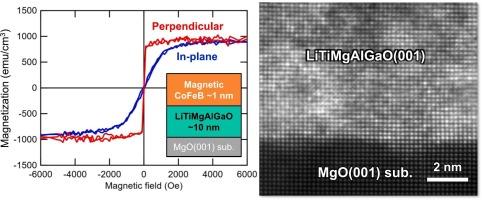具有界面垂直磁各向异性和隧道磁阻效应的高熵氧化物外延膜在自旋电子中的应用
IF 22
1区 材料科学
Q1 MATERIALS SCIENCE, MULTIDISCIPLINARY
引用次数: 0
摘要
由于多组分结构和功能材料新阶段的显著发展,通常由五种或五种以上具有高混合熵的组成元素组成的高熵材料越来越受到人们的关注。特别是,高熵氧化物(HEOs)有望在自旋电子学中实现其电子功能的潜力,因为实现功能所需的氧晶格除了阳离子位无序之外仍然存在。在这项研究中,我们探索了具有岩盐结构的LiTiMgAlGaO (l50)的HEO薄膜,其垂直磁各向异性(PMA)是在与CoFeB铁磁体的界面上产生的。在MgO(001)单晶衬底上进行原子溅射层合,获得了10 ~ 20nm厚l50o薄膜中原子均匀的阳离子分布。薄膜以高度(001)取向的外延生长方式生长,具有平均粗糙度为0.07 nm的原子平面。在250-350℃退火后,我们观察到l50层上CoFeB的垂直磁化,表明在HEO/铁磁体界面处引入了显著的PMA。由于实现了结构稳定的外延层,具有l50和CoFeB界面的高结晶度和锋利的界面平整度,在界面处观察到高达~ 0.8 erg/cm2的界面PMA能量。在室温下,在Fe/ l50 /Fe(001)外延磁隧道结(MTJs)中,在l50界面处插入超薄MgO,隧道磁电阻(TMR)比高达84%,这表明在heo基MTJs中也观察到自旋相关的相干隧道机制。此外,由于5个阳离子导致带隙减小,l50势垒具有低于1 eV的低势垒高度。高界面PMA能、相对较大的TMR比和较低的势垒高度表明,HEO材料可以成为下一代超高密度存储器和自旋人工智能设备等自旋电子器件超薄MTJs势垒的一个有前景的材料家族。本文章由计算机程序翻译,如有差异,请以英文原文为准。

High entropy oxide epitaxial films with interface perpendicular magnetic anisotropy and tunnel magnetoresistance effect toward spintronic applications
High entropy materials, usually composed of five or more constituent elements with a high mixing entropy have attracted increasing attention due to the marked development of new phases of multicomponent structural and functional materials. In particular, high entropy oxides (HEOs) are expected to realize their potential for electronic functionalities in spintronics, since the oxygen lattice required for achieving the functionalities remains besides the cation site disorder. In this study, we explored the HEO thin films with a rock-salt-like structure of LiTiMgAlGaO (L5O) for perpendicular magnetic anisotropy (PMA), which is induced at an interface with the CoFeB ferromagnet. The atomically homogeneous cation distributions in the 10–20 nm thick L5O films were achieved by atomic sputtering lamination on a MgO(001) single crystal substrate. The films were grown with a highly (001)-oriented epitaxial growth and have an atomically flat surface with an average roughness of 0.07 nm. We observed perpendicular magnetization of CoFeB on the L5O layer after 250–350 °C post-annealing, revealing that introduction of significantly large PMA at HEO/ferromagnet interfaces. A large interface PMA energy of up to ∼ 0.8 erg/cm2 at the interface was observed due to the achievement of structurally stable epitaxial layers with high crystallinity and sharp interfacial flatness of L5O and CoFeB interfaces. We also demonstrated that a tunnel magnetoresistance (TMR) ratio of up to 84 % at room temperature in epitaxial Fe/L5O/Fe(001) magnetic tunnel junctions (MTJs) with ultrathin MgO insertions at the L5O interfaces, indicating that the spin-dependent coherent tunneling mechanism is also observed in HEO-based MTJs. In addition, the L5O barrier exhibits low barrier heights less than 1 eV due to the bandgap reduction caused by the five cations. Our results of the high interface PMA energy, the relatively large TMR ratio, and the low barrier height show that the HEO materials can be a promising material family of ultra-thin barriers of MTJs for the next generation of spintronic devices such as ultra-high-density memory and spin artificial intelligence devices.
求助全文
通过发布文献求助,成功后即可免费获取论文全文。
去求助
来源期刊

Materials Today
工程技术-材料科学:综合
CiteScore
36.30
自引率
1.20%
发文量
237
审稿时长
23 days
期刊介绍:
Materials Today is the leading journal in the Materials Today family, focusing on the latest and most impactful work in the materials science community. With a reputation for excellence in news and reviews, the journal has now expanded its coverage to include original research and aims to be at the forefront of the field.
We welcome comprehensive articles, short communications, and review articles from established leaders in the rapidly evolving fields of materials science and related disciplines. We strive to provide authors with rigorous peer review, fast publication, and maximum exposure for their work. While we only accept the most significant manuscripts, our speedy evaluation process ensures that there are no unnecessary publication delays.
 求助内容:
求助内容: 应助结果提醒方式:
应助结果提醒方式:


